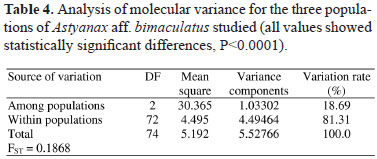Few reports are available about the ichthyofauna of typical semi-arid rivers, although the regional diversity has been constantly threatened by human activities, mainly related to impoundment and construction of dams. The goal of the present work was to evaluate using different methods, the population genetic structure of a characin fish, Astyanax aff. bimaculatus, widespread throughout hydrographic basins of Bahia, Northeastern Brazil. Morphological (meristic and morphometric data), cytogenetic (karyotype and Ag-NOR), and molecular (RAPD and SPAR) analyses were carried out in specimens collected upstream and downstream of Pedra Dam, in the main channel of Contas River (Contas River Basin), and in the Mineiro stream, which belongs to the adjacent Recôncavo Sul basin. Few external differences were detected among populations, where the individuals collected upstream of Pedra Dam were slightly larger than the others. Cytogenetic data also showed a similar karyotypic pattern (2n=50; 6m+28sm+12st+4a; FN= 96) and NORs located on the short arms of up to two chromosome pairs, with numerical inter- and intra-populational variation. Nonetheless, RAPD and SPAR analyses differentiated reliably the three populations, revealing striking differences in the allele frequencies among the localities studied and a significant difference in population structure index (Fst=0.1868, P<0.0001). The differences between populations within a same river were as significant as those between distinct hydrographic basins, indicating that the dam/reservoir represents an effective barrier to gene flow. Additionally, environmental peculiarities from each locality are also believed to influence the genetic patterns detected herein. On the other hand, the similarity between samples from Contas River and Recôncavo Sul basins could be related to a common evolutionary history, since both basins are geographically close to each other. Finally, the present study shows that a multi-approach analysis is particularly useful in identifying the population structure of widely distributed species and to evaluate the impacts of human activities on natural fish populations.
Morphometry; Cytogenetics; RAPD; Population structure; Contas River









